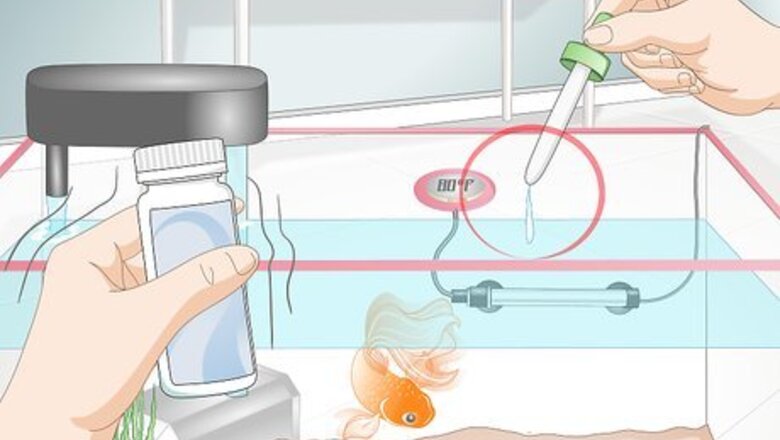
views
Setting the Right Conditions for Breeding
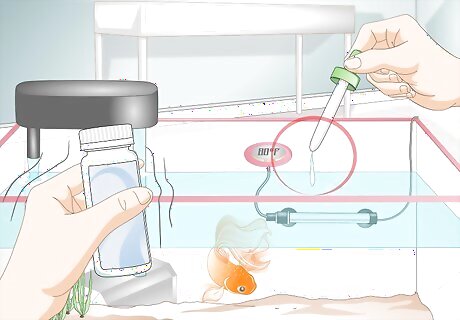
Plan far enough in advance. It takes a long time to create the right environment for mating. Buy your fish nearly a year in advance. July and August are the best months to purchase your fish, as goldfish like to breed during the Spring. You'll want your goldfish to be properly adjusted to their habitat and de-stressed before breeding season, so try to plan far enough in advance! The first thing you want to do (assuming you already have a smaller tank that can hold at least 4 gallons or 15 liters) is to clean your newly purchased breeders. By adding 80 eye drops of Formaldehyde, 6 drops of Copper Sulphate and just 1 small measure of Terramycin, you will be able to clean the goldfish and the tank to keep all healthy.
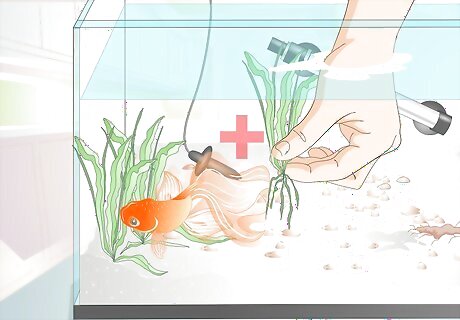
Create the right tank environment. The tank you plan to breed them in should hold at least 20 gallons (75.7 liters) of water. Additionally, add the necessary props for a natural-looking goldfish habitat. This normally includes natural or artificial bushy plants or fertile, sprawling fibers. When females lay their eggs, they usually anchor them to something solid. If you're going to let them breed naturally, you'll definitely want a lush environment. If you're going to breed them artificially, no plants are necessary, although they do improve quality of life (and act as a great water filter) when the fish are not breeding. Consider investing in spawning mops. Spawning mops are made of floating nylon string into which females send their eggs. You don't need spawning mops if you have plenty of brush, plants, or other fibrous material, but they're an easy, efficient way of safeguarding your goldfish eggs, as grown-up goldfish tend to eat any unsecured eggs.
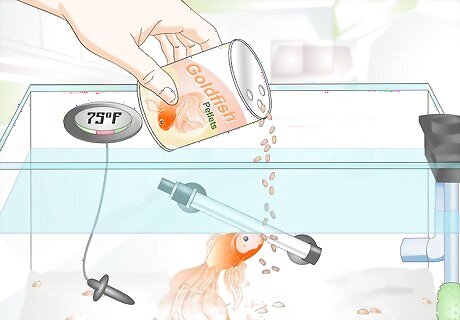
Start improving the diet of your goldfish. Without abruptly changing the diet of your goldfish, start introducing non-pellet food, such as brine shrimp or live black worms, into their tanks. This simulates the natural bounty of springtime when goldfish like to breed. A couple of pointers on feeding your goldfish in general: Feed your goldfish in small amounts but often. Feed them three times a day, being careful not to overfeed them. Many goldfish owners make the mistake of feeding their fish too much; the leftover scraps remain uneaten, sink to the bottom of the tank, decomposing and spoiling the water. No matter what you feed them, make sure you crumple it up small enough to fit in their mouths.
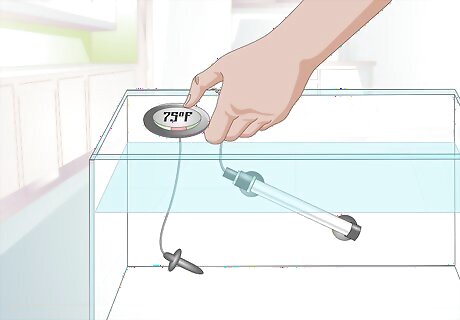
Simulate spring by dropping the temperature, then making it gradually warmer. Goldfish breed in the spring, so you want to replicate the heating up of the water. To do this, first, drop the temperature to between 10°C (50°F) and 12°C (54°F). Then, when you're ready to breed, raise the temperature by 2°C (3°F) per day, until the temperature is between 20°C (68°F) and 23°C (74°F).
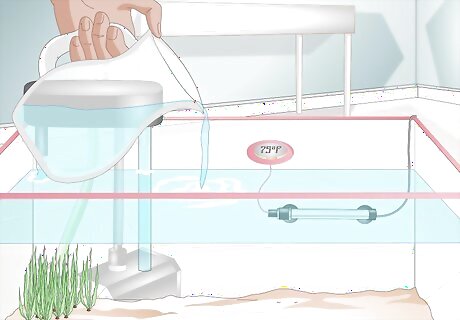
Make sure you're cycling out water every day. A partial water change is important to the general wellbeing of your fish and in stimulating breeding conditions specifically. Remove as much as 20% of the water in your tank daily, being sure not to exceed this amount. Remember to add water conditioner to the water that you cycle into the tank. Conditioners neutralize chemicals harmful to your fish, as well as remove chlorine and counteract chloramines.
Sexing and Isolating Your Goldfish
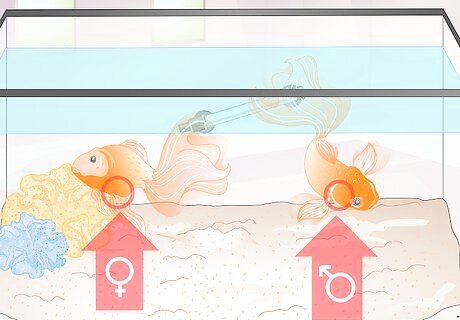
Know what a female goldfish tends to look like. Sexing your goldfish is probably the single most important task in breeding; obviously, if you put a bunch of males together because you can't tell them apart, you're not going to end up with any progeny. Here's what females tend to look like: Look at the shape of their vent. The vent is a small opening between the anus and the anal fin where fish excrete egg or sperm, depending on the sex. Female vents are rounded and convex, like an outie. Feel the abdomen. The abdomen, between the pelvic and anal fins, is very soft and movable for females. Look at the pectoral fins. The pectoral fins of females are round and short. Overall, female goldfish tend to be a bit smaller and rounder than male goldfish, who tend to be longer and pointier. This, however, is a less reliable way to tell the two apart.
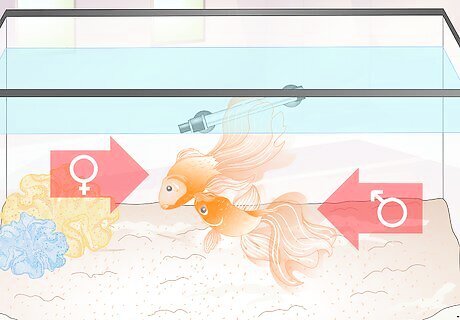
Know what a male goldfish tends to look like. Male goldfish tend to be a bit smaller than their female counterparts. They can also be distinguished by looking at the following traits: The presence of small white stars, or tubercles. Tubercles are little bumps that appear on the fins, head, and even gills of males when they're ready to breed. A concave, or innie, vent. Males have a vent that slices inward instead of bulges outward. Feel the abdomen. The abdomens of males are much more rigid and hard than those of females. Look at the pectoral fins. The pectoral fins of males are pointier and longer compared to the short, round pectoral fins of the females.
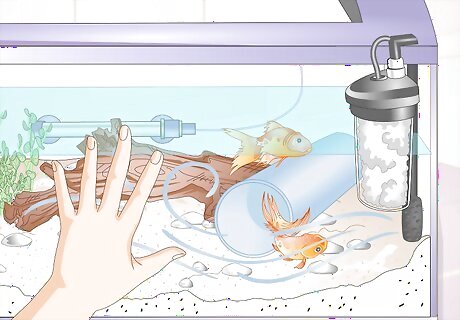
Look at the behavior of goldfish to tell apart males and females. During breeding season, males start chasing around females, sluggishly at first but with increasing fervor. Introduce a known female into the tank and look for the reaction of the other fish: Males will show a lot of interest, whereas females will show none!
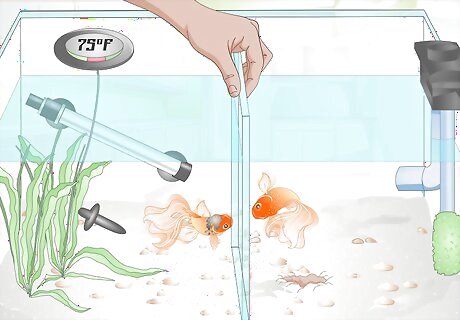
Consider isolating males and females for a couple weeks before breeding. Many breeders separate males and females at least a few weeks before breeding in order to create a greater desire to breed. Just like with humans, absence makes the heart grow fonder!
Breeding Your Goldfish
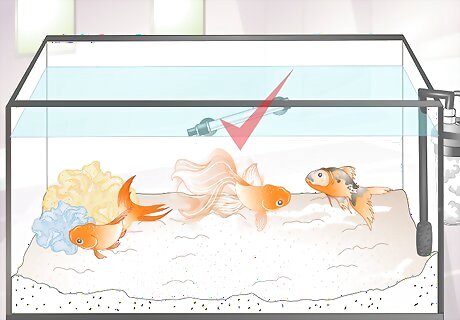
Choose your best breeders. Young robust goldfish are ideal because of their high fertility and sex-drive. For a female goldfish, look for ones with large rear and pectoral areas; for males, find a large mate (approximately anywhere from 4 to 6 inches) that is also a fast swimmer. Males with many small tubercles behind their heads on their gills is a sign of an ideal mate. For an ideal mix of breeders, try to isolate your three best male and two best female goldfish.
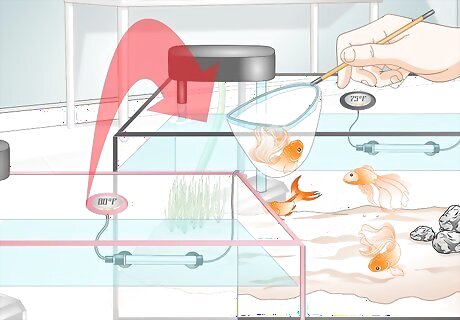
Introduce the five goldfish into the same tank and look for natural spawning. You will notice that the male goldfish will bear a lighter tint around their stomach area and be swimming swiftly around the tank, typically chasing the females. The female will drop the eggs over one of the plants, once the male goldfish will distribute sperm over the eggs to fertilize them. If you miss the moment of procreation but see eggs in the plants, they have likely been fertilized.
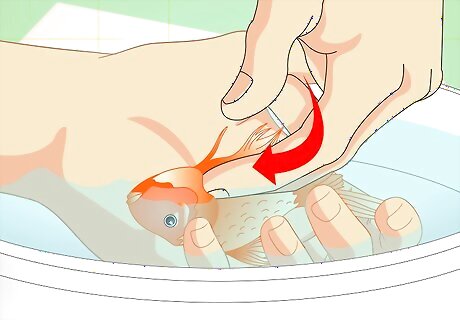
Artificially inseminate, if natural spawning proves unsuccessful. Introduce one male and one female together in a shallow tank. Gently hold the male goldfish and lightly rub his vent, clearing it of sperm. Swirl the sperm in the water and repeat the same process with the vent of the female, releasing her eggs. Swirl the water again to combine the sperm and the eggs. Be very ginger with artificial insemination. Your goldfish can bruise easily, so apply very light pressure when clearing their vents. You don't have to keep your goldfish underwater as you squeeze their vents. Goldfish, like other fish, can breathe outside of water, although not as well. Just be sure to keep them out of water for no more than 30 seconds at a time.
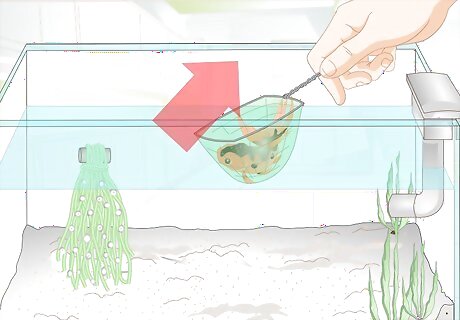
Separate your breeders from your eggs. Unfortunately, goldfish in captivity have a tendency to eat nearly all their eggs. This makes it necessary to separate the parents from their eggs almost immediately to ensure a full batch of eggs is hatched successfully. Fertilized eggs should hatch within 4 to 7 days, depending on the temperature of the water. When the eggs finally do hatch soon after they are fertilized, you can feed them the same food that you feed the adults. Just make sure that they are in even smaller bites than the adult food so their smaller mouths and throats are capable of ingestion. Try to keep the eggs in the same water they were bred in. Transplant only at your own risk.

Be patient while your fish develop and reach maturity. Soon you will have a whole litter of young goldfish swimming around your tank. Make sure the tank is big enough to accommodate all the young goldfish fry.










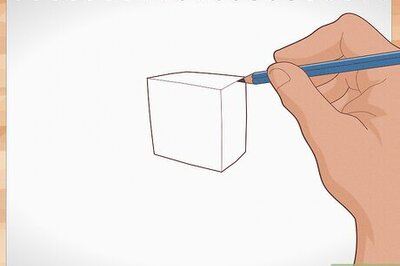

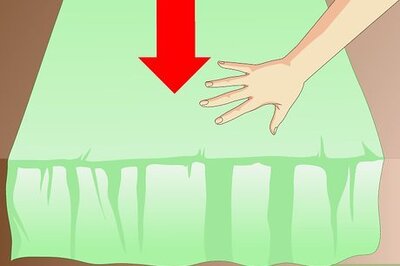







Comments
0 comment